STIHL BR 500, BR 600 Instruction Manual
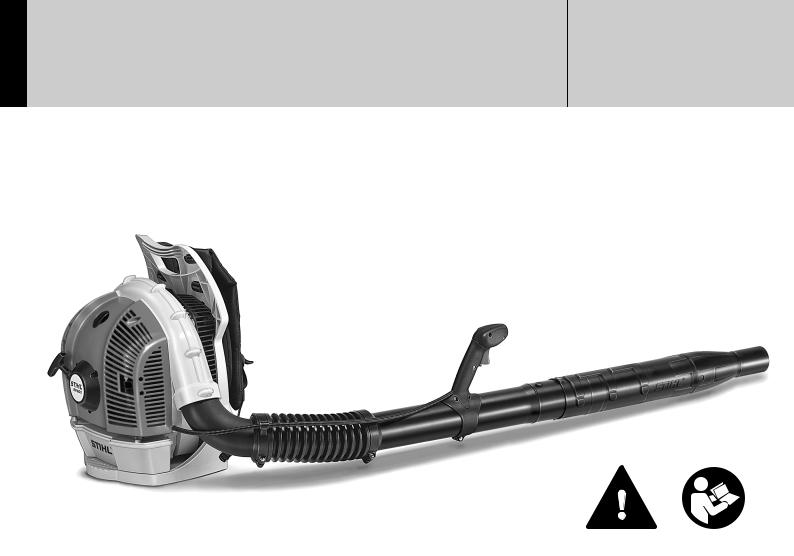
{
STIHL BR 500, 550, 600
Instruction Manual
Manual de instrucciones
 WARNING
WARNING
Read Instruction Manual thoroughly before use and follow all safety precautions – improper use can cause serious or fatal injury.
 ADVERTENCIA
ADVERTENCIA
Antes de usar la máquina lea y siga todas las precauciones de seguridad dadas en el manual de instrucciones – el uso incorrecto puede causar lesiones graves o mortales.
Instruction Manual 1 - 37
Manual de instrucciones 38 - 78
English
Contents
Printing inks contain vegetable oils, paper can be recycled.
Printed on chlorine-free paper Original Instruction Manual
© ANDREAS STIHL AG & Co. KG, 2015 0458-452-8621-G. VA4.A15. 0000006508_005_GB
Guide to Using this Manual |
2 |
STIHL Incorporated California |
Safety Precautions and Working |
|
Exhaust and Evaporative |
Techniques |
2 |
Emissions Control Warranty |
Assembling the Unit |
11 |
Statement |
Adjusting the Throttle Cable |
14 |
Trademarks |
Fitting the Harness |
14 |
|
4-MIX Engine |
15 |
|
Fuel |
15 |
|
Fueling |
16 |
|
Winter Operation |
18 |
|
Information Before You Start |
19 |
|
Starting / Stopping the Engine |
19 |
|
Operating Instructions |
21 |
|
Replacing the Air Filter |
22 |
|
Engine Management |
22 |
|
Adjusting the Carburetor |
23 |
|
Spark Plug |
24 |
|
Spark Arresting Screen in Muffler |
25 |
|
Rewind Starter |
25 |
|
Storing the Machine |
26 |
|
Inspections and Maintenance by |
|
|
Dealer |
26 |
|
Maintenance and Care |
27 |
|
Main Parts |
29 |
|
Specifications |
30 |
|
Maintenance and Repairs |
31 |
|
Disposal |
32 |
|
STIHL Incorporated Federal |
|
|
Emission Control Warranty |
|
|
Statement |
32 |
|
|
Allowonlypersonswhofullyunderstand |
|
this manual to operate your blower. |
34 |
To receive maximum performance and |
satisfactionfromyourSTIHLblower,itis |
36importantthatyouread,understandand follow the safety precautions and the operating and maintenance instructions in chapter "Safety Precautions and Working Techniques" before using your blower. For further information you can go to www.stihlusa.com.
Contactyour STIHLdealer or theSTIHL distributor for your area if you do not understandanyoftheinstructionsinthis manual.
 WARNING
WARNING
Because a blower is a high-speed tool, some special safety precautions must be observed as with any other power tool to reduce the risk of personal injury. Careless or improper use may cause serious or even fatal injury.
{This instruction manual is protected by copyright. All rights reserved, especially the rights to reproduce, translate and process with electronic systems.
BR 500, BR 550, BR 600 |
1 |
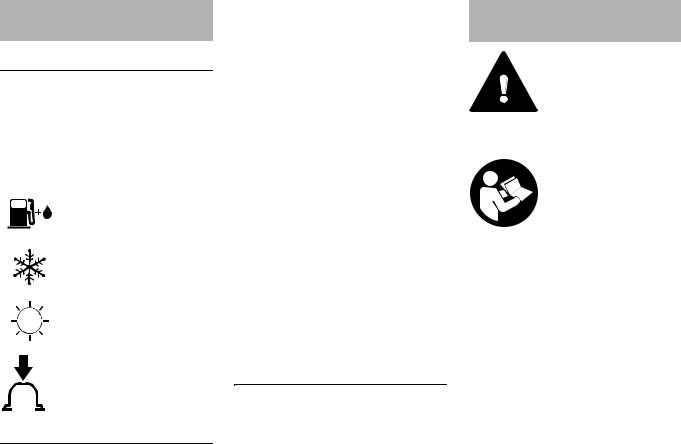
English
Guide to Using this Manual
Pictograms
The meanings of the pictograms attached to or embossed on the machine are explained in this manual.
Dependingonthemodelconcerned,the following pictograms may be on your machine.
Fuel tank for gasoline and engine oil mixture
Air intake winter mode
Air intake summer mode
Press to operate manual fuel pump
Symbols in Text
Many operating and safety instructions are supported by illustrations.
The individual steps or procedures describedinthe manualmaybe marked in different ways:
N A bullet marks a step or procedure.
A description of a step or procedure that refers directly to an illustration may contain item numbers that appear in the illustration. Example:
2
N Loosen the screw (1). N Lever (2) ...
In addition to the operating instructions, this manual may contain paragraphs that require your special attention. Such paragraphs are marked with the symbols and signal words described below:
 DANGER
DANGER
Indicates an imminent risk of severe or fatal injury.
 WARNING
WARNING
Indicates a hazardous situation which, if not avoided, could result in severe or fatal injury.
NOTICE
Indicates a risk of property damage, including damage to the machine or its individual components.
Engineering Improvements
STIHL’s philosophy is to continually improve all of its products. As a result, engineeringchangesandimprovements are made from time to time. Therefore, some changes, modifications and improvements may not be covered in this manual. If the operating characteristics or the appearance of your machine differs from those describedinthismanual,pleasecontact your STIHL dealer or the STIHL distributor for your area for assistance.
Safety Precautions and
Working Techniques
Because a blower is gasoline-powered and produces a strong air blast, special safety pre-
cautions must be observed to reduce the risk of personal injury.
It is important that you read, fully understand and observe the following safety precautions and warnings. Read the instruction manual and the safety precautions periodically. Careless or improper use may cause serious or fatal injury.
Have your STIHL dealer show you how to operate your power tool. Observe all applicable local safety regulations, standards and ordinances.
 WARNING
WARNING
Do not lend or rent your power tool without the instruction manual. Be sure that anyone using it understands the information contained in this manual.
 WARNING
WARNING
The use of this machine may be hazardous.
Useyourbloweronlyforclearingleaves, grass,paperanddustinyards,gardens, sport stadiums, parks, driveways and parking lots.
BR 500, BR 550, BR 600

 WARNING
WARNING
Do not use it for other purposes, since misuse may result in personal injury or property damage, including damage to the machine.
 WARNING
WARNING
Minors should never be allowed to use this power tool. Bystanders, especially children, and animals should not be allowed in the area where it is in use.
 WARNING
WARNING
Toreducetheriskofinjurytobystanders and damage to property, never let your power tool run unattended. When it is not in use (e.g. during a work break), shut it off and make sure that unauthorized persons do not use it.
Most of these safety precautions and warnings apply to the use of all STIHL blowers. Different models may have different parts and controls. See the appropriate section of your instruction manual for a description of the controls and the function of the parts of your model.
Do not clean your machine with a pressure washer. The solid jet of water may damage parts of the machine.
Safe use of a blower involves
1.the operator
2.the power tool
3.the use of the power tool.
THE OPERATOR
Physical Condition
You must be in good physical condition and mental health and not under the influence of any substance (drugs, alcohol, etc.) which might impair vision, dexterity or judgment. Do not operate this machine when you are fatigued.
 WARNING
WARNING
Be alert – if you get tired, take a break. Tiredness may result in loss of control. Working with any power tool can be strenuous.Ifyouhaveanyconditionthat mightbeaggravatedbystrenuouswork, check with your doctor before operating this machine.
 WARNING
WARNING
Prolonged use of a power tool (or other machines) exposing the operator to vibrations may produce white finger disease (Raynaud's phenomenon) or carpal tunnel syndrome.
These conditions reduce the hand's ability to feel and regulate temperature, produce numbness and burning sensations and may cause nerve and circulation damage and tissue necrosis.
All factors which contribute to white finger disease are not known, but cold weather, smoking and diseases or physical conditions that affect blood vessels and blood transport, as well as high vibration levels and long periods of exposure to vibration are mentioned as
English
factors in the development of white finger disease. In order to reduce the risk of white finger disease and carpal tunnel syndrome, please note the following:
–Most STIHL power tools are available with an anti-vibration ("AV") system designed to reduce the transmission of vibrations created by the machine to the operator's hands. An AV system is recommended for those persons using power tools on a regular or sustained basis.
–Keep your hands warm.
–Keep the AV system well maintained. A power tool with loose components or with damaged or worn AV elements will tend to have higher vibration levels.
–Maintain a firm grip at all times, but do not squeeze the handle with constant, excessive pressure. Take frequent breaks.
All the above-mentioned precautions do not guarantee that you will not sustain white finger disease or carpal tunnel syndrome. Therefore, continual and regular users should closely monitor the condition of their hands and fingers. If any of the above symptoms appear, seek medical advice immediately.
 WARNING
WARNING
The ignition system of the STIHL unit produces an electromagnetic field of a very low intensity. This field may interfere with some pacemakers. To reduce the risk of serious or fatal injury, persons with a pacemaker should
BR 500, BR 550, BR 600 |
3 |
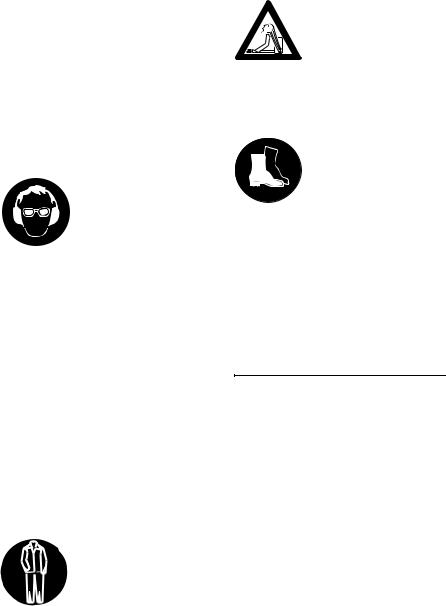
English
consult their physician and the pacemaker manufacturer before operating this tool.
Proper Clothing
 WARNING
WARNING
To reduce the risk of injury, the operator should wear proper protective apparel.
 WARNING
WARNING
To reduce the risk of injury to your eyes never
operate your power tool unless wearing goggles or properly fitted protec- tive glasses with adequate top and side protection complying with ANSI Z87 "+" (or your applicable national standard).
Power tool noise may damage your hearing. Wear sound barriers (ear plugs or ear mufflers) to protect your hearing. Continual and regular users should have their hearing checked regularly.
Be particularly alert and cautious when wearing hearing protection because your ability to hear warnings (shouts, alarms, etc.) is restricted.
Clothing must be sturdy and snug-fitting, but allow complete freedom of movement.
4
Avoid loose-fitting jack- ets, scarfs, neckties,
jewelry, flared or cuffed
pants, unconfined long hair or anything that could become drawn into the air intake. Secure hair so it is above shoulder level.
Good footing is very important. Wear sturdy boots with nonslip soles.
Steel-toed safety boots are recommended.
 WARNING
WARNING
To reduce the risk of injury when the inhalation of dust cannot be substantially controlled use an appropriate respirator for the material being blown. For more information see the "Working conditions" section of these Safety Precautions.
THE POWER TOOL
For illustrations and definitions of the power tool parts see the chapter on "Parts and Controls."
 WARNING
WARNING
Nevermodifythispowertoolinanyway. Only attachments supplied by STIHL or expressly approved by STIHL for use with the specific STIHL model are authorized. Although certain unauthorized attachments are useable with STIHL power tools, their use may, in fact, be extremely dangerous.
If this tool is subjected to unusually high loads for which it was not designed (e.g. heavy impact or a fall), always check that it is in good condition before continuing work.Checkin particularthat the fuel system is tight (no leaks) and that the controls and safety devices are working properly. Do not continue operating this machine if it is damaged. Incaseofdoubt,haveitcheckedbyyour STIHL servicing dealer.
 WARNING
WARNING
Smallparticles(e.g.dust)blownthrough the blower tubes and nozzle can cause a static charging of the blower tubes.
This is especially true in low humidity and high dust conditions. In order to reduce the risk of shock from static charging and subsequent injury from loss of control, your blower has features designed to help reduce the build up of static electricity in the blower tubes and equalize the charge with the engine and/or operator:
The control handle is designed to conduct static electricity through the throttle cable to the engine and from the handle through the operator to the ground.
STIHL offers an optional kit for use in especially dryand dustyconditions.The kit contains: (1) blower tubes made with graphitetohelpconductthechargeback to the control handle, and (2) a metal ring with "wire" for insertion in the end tube that helps reduce the buildup of static electricity.
Ifyourblowerisproperlyassembledand you are still experiencing static shocks, make sure that your foot ware has conductive soles and try operating your
BR 500, BR 550, BR 600
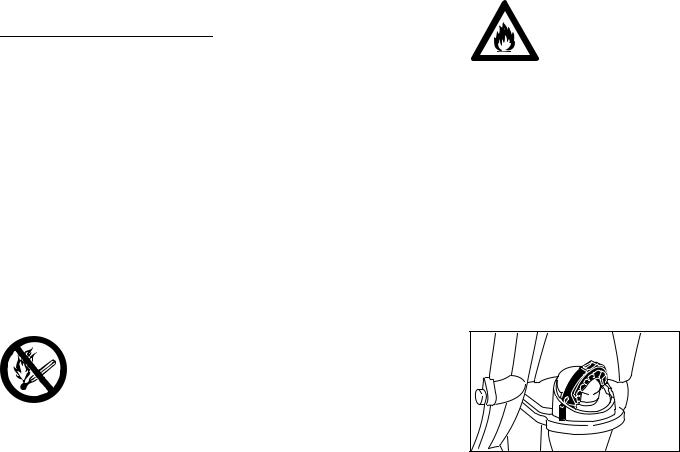
unit without gloves, which may be interfering with the conduction of the charge.
THE USE OF THE POWER TOOL
Transporting the Power Tool
 WARNING
WARNING
Always switch off the engine before taking the machine off your back and puttingitdown.Whentransportingitin a vehicle, properly secure it to prevent turnover, fuel spillage and damage to the unit.
Fuel
Your STIHL power tool uses an oilgasoline mixture for fuel (see the chapter on "Fuel” of your instruction manual).
 WARNING
WARNING
Gasoline is an extremely flammable fuel. If spilled and ignited by a spark or other ignition source, it can cause fire and seri-
ous burn injury or property damage. Use extreme caution when handling gasoline or fuel mix. Do not smoke or bring any fire or flame near the fuel or the power tool. Note that combusti- ble fuel vapor may escape from the fuel system.
Fueling Instructions
 WARNING
WARNING
To reduce the risk of serious injury from burns, never attempt to refuel the unit until it has been completely removed from the operator.
 WARNING
WARNING
Fuel your power tool in well-ventilated areas, outdoors. Always shut off the engine and allow it to cool before refueling. Gasoline vapor pressure may build up inside the fuel tank depending on the fuel used, the weather conditions and the tank venting system.
In order to reduce the risk of burns and other personal injury from escaping gas vapor and fumes, remove the fuel filler caponyourpowertoolcarefullysoasto allow any pressure build-up in the tank to releaseslowly.Neverremove thefuel filler cap while the engine is running.
Selectbare groundforfuelingandmove at least 10 feet (3 m) from the fueling spot before starting the engine. Wipe off any spilled fuel before starting your machine.
BR 500, BR 550, BR 600
English
 WARNING
WARNING
Check for fuel leakage while refueling and during operation. If fuel leakage is found, do not start or run the engine until the leak is fixed and any spilled fuel has been wiped away. Take care not to get fuel on your clothing. If this happens, change your clothing immediately.
 WARNING
WARNING
Inordertoreducetheriskoffuelspillage and fire from an improperly tightened fuel cap, correctly position and tighten the fuel cap in the fuel tank opening.
Different models may be equipped with different fuel caps.
Toolless cap with grip
452BA116 KN
To do this with this STIHL cap, raise the griponthetopofthecapuntilitisupright at a 90° angle. Insert the cap in the fuel tank opening with the raised positioning marks on the grip of the cap and on the fuel tank opening lining up. Using the grip, press the cap down firmly while turning it clockwise as far as it will go (approx. 1/4 turn).
5
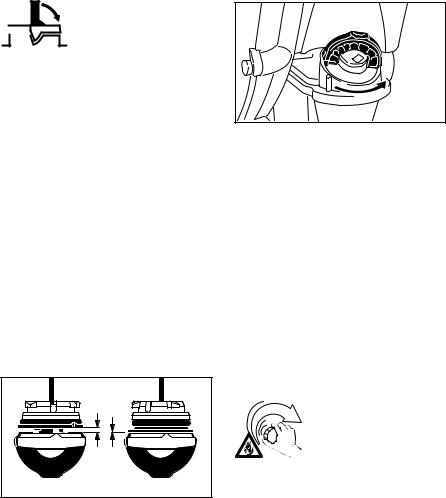
English
Fold the grip flush with the top of the cap. Grip 



 the cap and check for tightness. If the grip does not lie completely flush
the cap and check for tightness. If the grip does not lie completely flush
with the cap and the detent on the grip does not fit in the correspond- ing recess in the filler opening, or if the cap is loose in the filler opening, the cap is not properly seated and tightened and you must repeat the above steps.
Misaligned, damaged or broken cap
If the cap does not drop fully into the openingwhenthepositioningmarksline up and/or if the cap does not tighten properly when twisted, the base of the cap may be prematurely rotated (in relationtothetop)totheclosedposition. Such misalignment can result from handling, cleaning or an improper attempt at tightening.
001BA227 KN |
Left: |
Base of cap in closed posi- |
|
tion (with open space) |
Right: |
Base of cap correctly posi- |
|
tioned for installation |
452BA121 KN
Toreturnthecaptotheopenpositionfor installation, turn the cap (with the grip up) until it drops fully into the tank opening. Next, twist the cap counterclockwise as far as it will go (approx. 1/4 turn) – this will twist the base of the cap into the correct position. Then, twist the cap clockwise, closing it normally.
Ifyourcapstilldoesnottightenproperly, it may be damaged or broken; immediately stop use of the unit and take it to your authorized STIHL dealer for repair.
Screw Cap
 WARNING
WARNING
Unit vibrations can cause an improperly tightened fuel filler cap to loosen or
come off and spill quanti- ties of fuel. In order to reduce the risk of fuel spillage and fire, tighten the fuel filler cap by hand as securely as possible.
See also the "Fueling" chapter in your Instruction Manual for additional information.
Before Starting
 WARNING
WARNING
Alwayscheckyourpowertool for proper condition and operation before starting, particularly the throttle trigger, setting leverandstopswitch.Thethrottletrigger must move freely and always spring back to the idle position. Never attempt to modify the controls or safety devices.
 WARNING
WARNING
Check fuel system for leaks, especially the visible parts, e.g., filler cap, hose connections,manualfuel pump(onlyfor powertoolsequippedwithamanualfuel pump). Do not start the engine if there are leaks or damage – risk of fire! Have the machine repaired by a servicing dealer before using it.
 WARNING
WARNING
Never operate your power tool if it is damaged, improperly adjusted or maintained, or not completely or securely assembled.
 WARNING
WARNING
Check that the spark plug boot is securely mounted on the spark plug – a loose boot may cause arcing that could ignite combustible fumes and cause a fire.
Keep the handles clean and dry at all times; it is particularly important to keep themfreeofmoisture,pitch,oil,fuelmix, grease or resin in order for you to maintain a firm grip and properly control your power tool.
6 |
BR 500, BR 550, BR 600 |
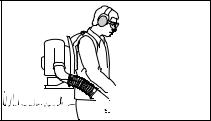
 WARNING
WARNING
To reduce the risk of injury from parts thrown by the fan wheel, check the fan housing for damage (cracks or holes that could allow foreign objects to contact the fan wheel). If any such damageisfound,stopusingtheunitand contact your STIHL dealer for repair.
 WARNING
WARNING
Adjust carrying harness to suit your size before starting work.
Inanemergency,youmayslipoutofthe harness and throw off the machine quickly.Tryslippingout oftheharnessa number of times before using the machine in order to become accustomed to it. Do not throw off the machine while practicing as it could damage the machine.
Starting
To reduce the risk of fire and burn injuries, start the engine at least 10 feet (3 m) from the fueling spot, outdoors only.
 WARNING
WARNING
Your power tool is a one-person machine. To reduce the risk of eye or other injury from thrown objects, insure that bystanders are at least 50 feet (15 m) away during use. Stop operation immediately if you are approached.
 WARNING
WARNING
This unit is equipped with an ignition system that is normally in operational readiness. Afterthesetting leverisused
to stop the engine, it automatically springs back to the "on" position. If the engine is warm, it may be possible to start it by simply pulling the starter rope, with no further adjustments. To reduce the risk of injury, be particularly alert to keep children away from the unit.
Forspecificstartinginstructions,seethe appropriate section of your manual. Place the power tool on firm ground or other solid surface in an open area. Maintain good balance and secure footing.
 WARNING
WARNING
When you pull the starter grip, do not wrap the starter rope around your hand. Do not let the grip snap back, but guide the starter rope to rewind it properly. Failure to follow this procedure may result in injury to your hand or fingers and may damage the starter mechanism.
Once the engine has started, immediately blip the throttle trigger, which should cause the choke knob to move to the run position and allow the engine to slow down to idle.
English
During Operation
Holding and Controlling the Power Tool















 0009BA001 KN
0009BA001 KN
The blower is designed for singlehanded operation with the right hand on the control handle. It should be carried as a backpack with the straps of the harness over both shoulders.
Watch out for small animals when using thebloweronopenground,inyardsand gardens.
 WARNING
WARNING
To reduce the risk of loss of control, never carry the unit with the strap(s) over one shoulder.
Wrap your fingers tightly around the handle, keeping the control handle cradled between your thumb and forefinger. Keep your hand in this position to have your machine under control at all times.
 WARNING
WARNING
Special care must be taken in slippery conditions (wet ground) and in difficult, overgrown terrain. Watch for hidden obstacles such as tree stumps, roots, rocks, holes and ditches to avoid stumbling.Forbetterfooting,clearaway
BR 500, BR 550, BR 600 |
7 |

English
fallen branches, scrub and cuttings. Be extremely cautious when working on slopes or uneven ground.
To reduce the risk of stumbling and loss of control, do not walk backward while operating the machine.
 WARNING
WARNING
To reduce the risk of injury from loss of control,neverworkonaladderoronany other insecure support.
Working Conditions
To minimize blowing time, use a rake andbroomtoloosendirtparticlesbefore you start blowing.
Save water by using a blower instead of a water hose for lawn and garden work wherever possible, e.g. for cleaning yards and patios.
Recommended working technique to minimize air pollution:
–Ifconditionsareverydusty,dampen surfaces slightly before blowing.
–Pull out the nozzle to full length so that the airstream is at ground level.
–Donotblowparticlesinthedirection of bystanders, in particular in the direction of children, pets, open windows or freshly washed vehicles. Take special care in such situations.
–Remove the blow-swept debris in rubbishbins–donotblowitontothe neighbor's land.
8
Recommended working technique to minimize noise:
–Operate your power tool at reasonable times only – not early in the morning, late at night or during midday rest periods when people could be disturbed. Observe local rest periods. Normal recommendation for professional use on weekdays: 9:00hrs to 12:00hrs and 15:00hrs to 17:00hrs. Be considerate of neighbors at weekends.
–Fewer engines mean less noise. Where possible, do not run more than one power tool at any time.
–Operate blowers at the lowest engine speed necessary to accomplish the task.
–Check your blower before starting work. Pay special attention to the muffler, air intakes and air filter.
Operate and start your power tool only outdoors in a well-ventilated area. Operate it under good visibility and daylight conditions only. Work carefully.
 WARNING
WARNING
As soon as the engine is running, this product gen- erates toxic exhaust
fumes containing chemi- cals, such as unburned hydrocarbons (including benzene) and carbon monoxide, that are known to cause respira- tory problems, cancer, birth defects, or other reproductive harm. Some of the gases (e.g. carbon monoxide) may be color- less and odorless. To reduce the risk of serious or fatal injury/illness from inhaling toxic fumes, never run the machine indoors or in poorly venti- lated locations. If exhaust fumes become concen- trated due to insufficient ventilation, clear obstruc- tions from work area to permit proper ventilation before proceeding and/or take frequent breaks to allow fumes to dissipate before they become concentrated.
 WARNING
WARNING
Inhalation of certain dusts, especially organic dusts such as mold or pollen, can cause susceptible persons to have an allergic or asthmatic reaction.
Substantial or repeated inhalation of dustandotherairbornecontaminants,in particular those with a smaller particle size, may cause respiratory or other
BR 500, BR 550, BR 600
illnesses. This includes wood dust, especially from hardwoods, but also from some softwoods such as Western Red Cedar. Control dust at the source where possible. Use good work practices, such as operating the unit so that the wind or operating process directsanydustraisedbythepowertool away from the operator. Follow the recommendations of EPA/OSHA/NIOSH and occupational and trade associations with respect to dust ("particulate matter"). When the inhalation of dust cannot be substantially controlled, i.e., kept at or neartheambient(background)level,the operator and any bystanders should wear a respirator approved by NIOSH/MSHA for the type of dust encountered.
 WARNING
WARNING
If the substance being blown is a commercial substance, review the material safety data sheet for that substance and / or consult the material manufacturer / supplier. The state of California and some other authorities, for instance, have published lists of substances known to cause cancer, reproductive toxicity, etc.
 WARNING
WARNING
Breathing asbestos dust is dangerous and can cause severe or fatal injury, respiratory illness or cancer. The use and disposal of asbestos-containing products have been strictly regulated by OSHAandtheEnvironmentalProtection Agency. If you have any reason to believe that you might be blowing or
otherwise disturbing asbestos, immediately contact your employer or a local OSHA representative.
 WARNING
WARNING
Dust with silica in its composition may containcrystallinesilica.Silicaisabasic component of sand, quartz, brick, clay, granite and numerous other minerals and rocks, including masonry and concrete products. Repeated and / or substantial inhalation of airborne crystalline silica can cause serious or fatal respiratory disease, including silicosis. In addition, the state of California and some other authorities havelistedrespirablecrystallinesilicaas a substance known to cause cancer. When encountering such materials, always follow the respiratory precautions mentioned above.
Operating Instructions
 WARNING
WARNING
In the event of an emergency, switch off the engine immediately – move the setting lever to 0 or STOP.
 WARNING
WARNING
Even though bystanders should be kept awayfromtherunningpowertool,never work alone. Keep within calling distance of others in case help is needed.
Stop the engine immediately if you are approached.
English
 WARNING
WARNING
To reduce the risk of personal injury, do not direct air blast towards bystanders, since the high pressure of the air flow can injure eyes and can blow small objects at great speed.
 WARNING
WARNING
The blower fan between the air intake and output openings rotates whenever the engine is running.
Never insert any foreign object into the air intake of the machine or into the nozzle of the blower. It will damage the fan wheel and may cause serious injury to the operator or bystanders as a result of the object or broken parts being thrown out at high speed.
Do not place the blower on the ground when operating at high speed, because small objects such as sand, grass, dust, etc.maybepulledintotheairintakeand damage the fan wheel. It is best to turn the machine off when putting it on the ground.
 WARNING
WARNING
Never modify your muffler. Any modification could cause an increase in heat radiation, sparks or sound level, thereby increasing the risk of fire, burn injury or hearing loss. You may also permanently damage the engine. Have your muffler serviced and repaired by your STIHL servicing dealer only.
BR 500, BR 550, BR 600 |
9 |

English
 WARNING
WARNING
Themufflerandotherpartsoftheengine (e.g. fins of the cylinder, spark plug) becomehotduringoperationandremain hot for a while after stopping the engine. Toreduceriskofburns,donottouchthe muffler and other parts while they are hot. Keep the area around the muffler clean. Remove excess lubricant and all debris such as pine needles, branches or leaves. Let the engine cool down sitting on concrete, metal, bare ground or solid wood away from any combustible substances.
 WARNING
WARNING
An improperly mounted or damaged cylinder housing or a damaged/deformed muffler shell may interfere with the cooling process of the muffler. To reduce the risk of fire or burn injury, do not continue work with a damaged or improperly mounted cylinder housing or a damaged/deformed muffler shell.
Your muffler is furnished with a spark arresting screen designed to reduce the risk of fire from the emission of hot particles. Never operate your unit with a missing or damaged spark arresting screen.Ifyourgas/oilmixratioiscorrect (i.e., not too rich), this screen will normally stay clean as a result of the heat from the muffler and need no service or maintenance. If you experiencelossofperformanceandyou suspect a clogged screen, have your muffler maintained bya STIHLservicing dealer. Some state or federal laws or regulations may require a properly maintained spark arrestor for certain
10
uses.Seethe"Maintenance,Repairand Storing" section of these Safety Precautions. Remember that the risk of a brush or forest fire is greater in hot or dry conditions.
 WARNING
WARNING
Some STIHL power tools are equipped with a cata- lytic converter, which is
designed to reduce the exhaust emissions of the engine by a chemical process in the muffler. Due to this process, the muffler does not cool down as rapidly as con- ventional mufflers when the engine returns to idle or is shut off. To reduce the risk of fire and burn injuries when using a cat- alytic converter, always set your power tool down in the upright position and never locate it where the muffler is near dry brush, grass, wood chips or other combustible materi- als while it is still hot.
MAINTENANCE, REPAIR AND STORING
Maintenance, replacement, or repair of the emission control devices and systems may be performed by any nonroad engine repair establishment or individual. However, if you make a warranty claim for a component which has not been serviced or maintained
properly or if nonapproved replacement parts were used, STIHL may deny coverage.
 WARNING
WARNING
Use only identical STIHL replacement partsformaintenanceandrepair.Useof non-STIHL parts may cause serious or fatal injury.
Strictly follow the maintenance and repair instructions in the appropriate section in this instruction manual.
Please refer to the maintenance chart in this instruction manual.
 WARNING
WARNING
Always stop the engine and make sure that the fan is stopped before doing any maintenance or repair work or cleaning the power tool. Do not attempt any maintenance or repair work not described in this instruction manual. Have such work performed by your STIHL servicing dealer only.
Do not clean your machine with a pressure washer. The solid jet of water may damage parts of the machine.
 WARNING
WARNING
Use the specified spark plug and make sure it and the ignition lead are always clean and in good condition. Always press spark plug boot snugly onto spark plugterminalofthepropersize.(Note:If terminal has detachable SAE adapter nut, it must be securely attached.) A loose connection between spark plug terminal and the ignition wire connector in the boot may create arcing that could ignite combustible fumes and cause a fire.
BR 500, BR 550, BR 600
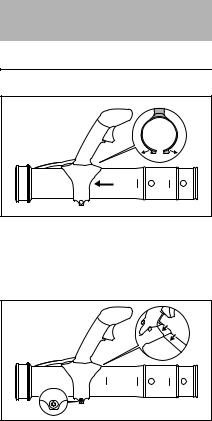
 WARNING
WARNING
Never test the ignition system with the boot removed from the spark plug or with a removed spark plug, since uncontained sparking may cause a fire.
 WARNING
WARNING
Do not operate your power tool if the mufflerisdamaged,missingormodified. An improperly maintained muffler will increasetheriskoffireandhearingloss. Your muffler is equipped with a sparkarresting screen to reduce the risk of fire; never operate your power tool if the screen is missing, damaged or clogged. Remember that the risk of a brush or forest fire is greater in hot or dry weather.
In California, it is a violation of § 4442 or § 4443 of the Public Resources Code to use or operate gasoline-powered tools on forest-covered, brush-covered or grass-covered land unless the engine’s exhaust system is equipped with a complying spark arrester that is maintained in effective working order. The owner/operator of this product is responsible for properly maintaining the spark arrester. Other states or governmentalentities/agencies,suchas the U.S. Forest Service, may have similar requirements. Contact your local fire agency or forest service for the laws or regulations relating to fire protection requirements.
Tightenallnuts,boltsandscrewsexcept the carburetor adjustment screws after each use.
Formaintenanceitemspleasealsorefer to the maintenance chart in this instruction manual.
Store the power tool in a dry and high or locked location out of reach of children.
Before storing for longer than a few days, always empty the fuel tank. See chapter "Storing the machine" in this instruction manual.
Store fuel in an approved and properly labeled safety-type canister only. Take carewhenhandlinggasoline!Forhealth and safety reasons, avoid direct contact with the skin and avoid inhaling fuel vapor!
English
Assembling the Unit
Mounting the Control Handle
2 |
1 |
KN |
|
452BA101 |
|||
|
|||
|
|
NPull the two halves of the clamp apart.
NPushthecontrolhandle (1)ontothe blower tube (2).
1 |
2 |
KN |
|
452BA102 |
|
3 |
|
NLine up the control handle (1) with the tube's seam – as shown.
NSecure the control handle (1) with the screw (3) so that it can still be moved on the blower tube (2).
BR 500, BR 550, BR 600 |
11 |
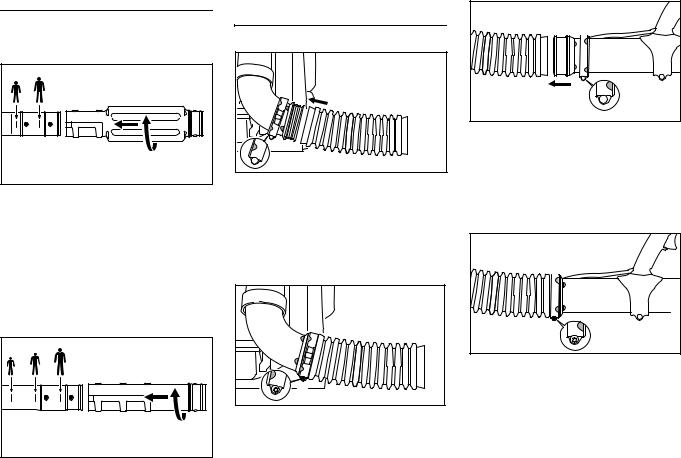
English
Mounting the Blower Tubes
BR 500
|
|
1 |
|
2 |
3 |
KN |
|
452BA095 |
|||
|
|
NDepending on your size and reach: Push blower tube (1) up to the appropriate mark on the blower tube (2).
NRotate the blower tube (1) in the direction of the arrow and engage it in the appropriate slot (3).
BR 550, BR 600
|
|
1 |
|
2 |
3 |
KN |
|
452BA096 |
|||
|
|
NDepending on your size and reach: Push blower tube (1) up to the appropriate mark on the blower tube (2).
NRotate the blower tube (1) in the direction of the arrow and engage it in the appropriate slot (3).
Mounting the Hose Clamps and Pleated
Hose
3 |
1 |
2 |
|
|
452BA108 KN |
NPush the hose clamp (1) (with retainer for throttle cable) onto the elbow (3) – the positioning marks must face to the left.
NPush the pleated hose (2) over the elbow (3).
3 |
1 |
2 |
|
||
4 |
|
452BA109 KN |
NPush the hose clamp (1) onto the pleated hose (2).
NLineupthepositioningmarksonthe hose clamp (1) and elbow (3) – the screw eye faces down.
NSecure the hose clamp (1) with the screw (4).
2 |
5 |
|
6 |
|
452BA103 KN |
NPush the hose clamp (5) (without retainer for throttle cable) onto the elbow (6) – the positioning marks must face to the right.
NPush the blower tube (6) into the pleated hose (2).
2 |
5 |
|
|
|
6 |
|
7 |
KN |
|
452BA104 |
|
|
|
NPush the hose clamp (5) onto the pleated hose (2).
NLine up the hose clamp (5) and blower tube (6) – as shown.
NSecure the hose clamp (5) with the screw (7).
12 |
BR 500, BR 550, BR 600 |
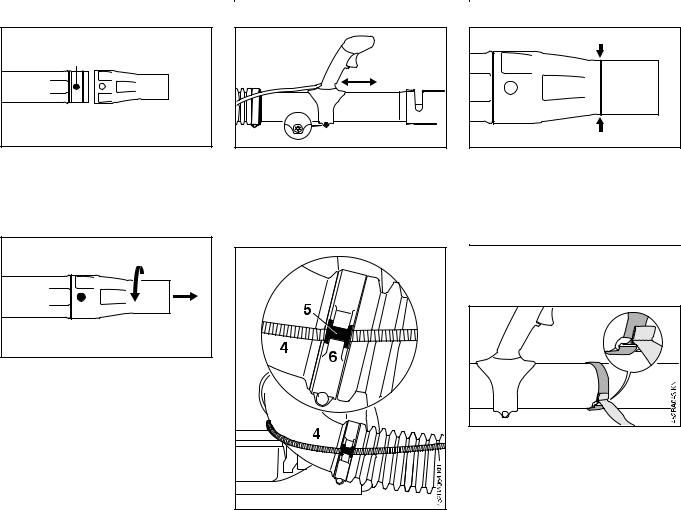
English
Mounting the nozzle |
|
Adjusting the Control Handle |
|
Wear Mark on Nozzle |
|
3 |
2 |
1 |
|
452BA111 KN |
NPush the nozzle (1) onto the blower tube (2) and engage it on the lugs (3).
Removing the Nozzle
2 |
3 |
1 |
|
KN |
|
|
|
452BA112 |
NRotatethenozzle (1)inthedirection of the arrow until the lugs (3) are covered.
NPull the nozzle (1) off the blower tube (2).
1 |
2 |
KN |
3 |
|
452BA110 |
NMove the control handle (1) along the blower tube (2) to the most comfortable position.
NSecure the control handle (1) with the screw (3).
452BA100 KN
The front end of the nozzle is worn by ground contact during operation. Replace the nozzle when it has worn as far as the wear mark.
Fitting the Transport Aid
When storing or transporting the machine:
N Securethevelcrostriptotheblower tube – pull the flap through the buckle.
NEngage the throttle cable (4) with sleeve (5) in the retainer (6).
BR 500, BR 550, BR 600 |
13 |
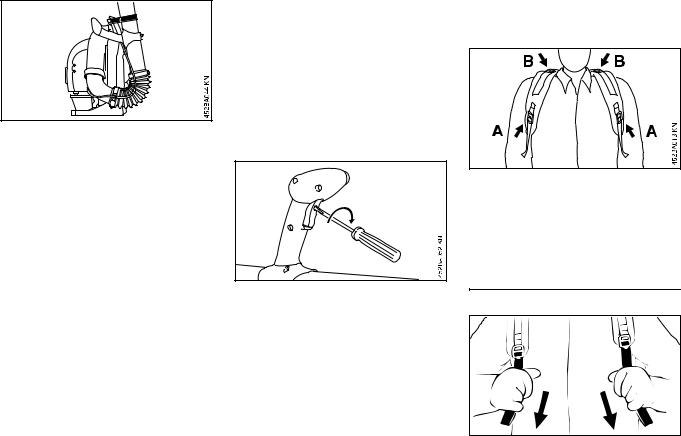
English
NSecure the blower tube to the handle on the backplate.
Adjusting the Throttle Cable |
|
Fitting the Harness |
|
|
|
It may be necessary to correct the adjustment of the throttle cable after assembling the machine or after a prolonged period of operation.
Adjust the throttle cable only when the unit is completely and properly assembled.
NSet throttle trigger to the full throttle position – as far as stop.
NCarefully screw home the screw in the throttle trigger until you feel initial resistance.
NAdjust the harness straps so that the backplate fits snugly and securely against your back.
A Adjust height
BAdjust angle
Tightening the harness straps
373BA003 KN
NPull the ends of the straps downward.
14 |
BR 500, BR 550, BR 600 |

Loosening the harness straps
373BA004 KN
N Lift the tabs of the sliding adjusters.
4-MIX Engine
The STIHL 4-MIX engine features mixture lubrication andmustbe runona fuel mixture of gasoline and engine oil.
It operates otherwise on the 4-stroke principle.
English
Fuel
This engine is certified to operate on unleaded gasoline and the STIHL twostroke engine oil at a mix ratio of 50:1.
Your engine requires a mixture of highquality gasoline and two-stroke air cooled engine oil.
Usemid-gradeunleadedgasolinewitha minimum octane rating of 89 ((R+M)/2) and no more than 10% ethanol content.
Fuel with a lower octane rating may increase engine temperatures. This, in turn, increases the risk of piston seizure and damage to the engine.
The chemical composition of the fuel is also important. Some fuel additives not only detrimentally affect elastomers (carburetor diaphragms, oil seals, fuel lines,etc.),butmagnesiumcastingsand catalytic converters as well. This could cause running problems or even damage the engine. For this reason STIHL recommends that you use only high-quality unleaded gasoline!
Gasoline with an ethanol content of more than 10% can cause running problems and major damage in engines and should not be used.
The ethanol content in gasoline affects engine running speed – it may be necessary to readjust the carburetor if you use fuels with various ethanol contents.
 WARNING
WARNING
To reduce the risk of personal injury from loss of control and/or contact with the running cutting tool, do not use your
BR 500, BR 550, BR 600 |
15 |
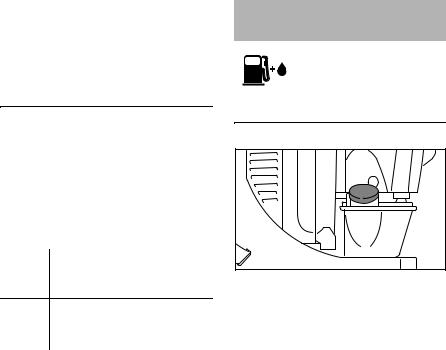
English
unit with incorrect idle adjustment. At correct idle speed, the cutting tool should not move.
Ifyourpowertoolshowsanincorrectidle adjustment, have your STIHL dealer check your power tool and make proper adjustments and repairs.
The idle speed and maximum speed of the engine change if you switch from a fuel with a certain ethanol content to another fuel with a much higher or lower ethanol content.
This problem can be avoided by always using fuel with the same ethanol content.
Use only STIHL two-stroke engine oil or equivalent high-quality two-stroke engine oils that are designed for use only in air cooled two-cycle engines.
WerecommendSTIHLHPUltra2-Cycle Engine Oil since it is specially formulated for use in STIHL engines.
Do not use BIA or TCW rated (twostroke water cooled) mix oils or other mixoilsthatstatetheyareforuseinboth water cooled and air cooled engines (e.g., outboard motors, snowmobiles, chain saws, mopeds, etc.).
 WARNING
WARNING
Take care when handling gasoline. Avoid direct contact with the skin and avoid inhaling fuel vapor. When filling at the pump, first remove the container from your vehicle and place the containeronthegroundbeforefilling.To reduce the risk of sparks from static discharge and resulting fire and/or explosion, do not fill fuel containers that are sitting in or on a vehicle or trailer.
The container should be kept tightly closed in order to limit the amount of moisture that gets into the mixture.
The machine‘s fuel tank should be cleaned as necessary.
Fuel mix ages
Only mix sufficient fuel for a few days work, not to exceed 30 days of storage. Store in approved fuel-containers only. When mixing, pour oil into the container first, and then add gasoline. Close the container and shake it vigorously by hand to ensure proper mixing of the oil with the fuel.
Gaso- |
Oil (STIHL 50:1 or equiva- |
line |
lent high-quality oils) |
US gal. |
US fl.oz. |
12.6
2 1/2 |
6.4 |
512.8
Dispose of empty mixing-oil containers only at authorized disposal locations.
Fueling
Preparations |
452BA123 KN |
NBefore fueling, clean the filler cap andtheareaaroundittoensurethat no dirt falls into the tank.
Always thoroughly shake the mixture in the canister before fueling your machine.
 WARNING
WARNING
In order to reduce the risk of fire and personalinjuryfromescaping gasvapor and fumes, remove the fuel filler cap carefully so as to allow any pressure build-up in the tank to release slowly.
One of two different filler caps is installed as standard at the factory.
16 |
BR 500, BR 550, BR 600 |
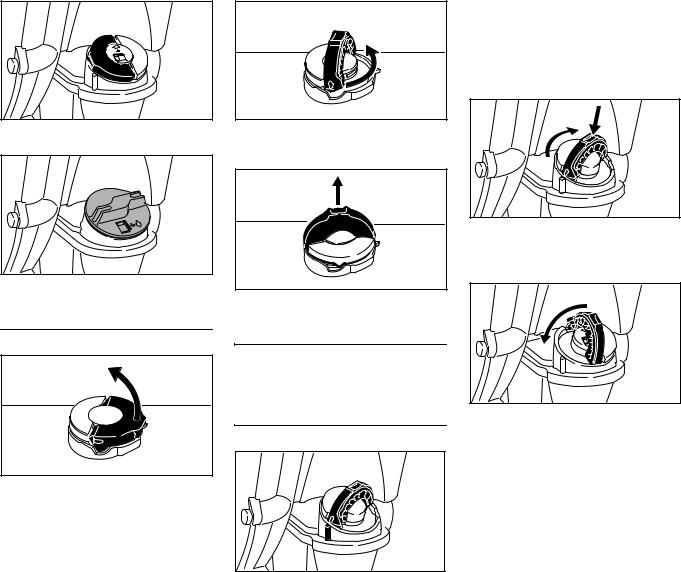
452BA119 KN
Toolless filler cap (with folding grip)
452BA125 KN
Threaded filler cap
Opening the toolless filler cap
001BA218 KN |
NRaise the grip into an upright position.
001BA219 KN |
NTurn the cap counterclockwise (approx. 1/4 turn).
001BA224 KN |
N Remove fuel filler cap.
Refueling
Take care not to spill fuel while fueling, and do not overfill the tank.
Closing the toolless filler cap
452BA116 KN
With grip in an upright position:
English
NInsert the cap – the raised positioning marks on the cap and the fuel tank opening must line up.
NThe cap should drop fully into the opening in this position. Make sure tank is not overfilled.
452BA117 KN
NWhile pressing the cap down firmly, twist it clockwise as far as it will go (approx. 1/4 turn).
452BA118 KN
N Fold down the grip.
BR 500, BR 550, BR 600 |
17 |
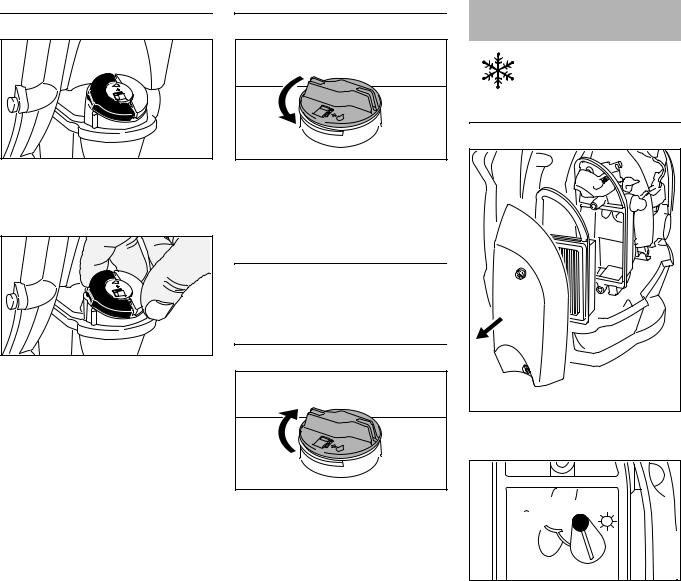
English
Checking for proper closure
452BA119 KN
NThe lug on the grip must engage entirely in the recess (arrow), and the grip must lie completely flush with the top of the cap.
452BA120 KN
NGrip the cap and check for tightness.
NIf the cap can be moved, it is not properly installed.
NIf the cap does not tighten properly, the cap parts may be misaligned with each other, or the cap may be damaged or broken. See the "Fueling Instructions" section of the Safety Precautions for how to correct a misaligned cap and additional information. Never use your machine with a misaligned, damaged or broken cap.
Opening the threaded filler cap
002BA447 KN |
NTurn the cap counterclockwise until it can be removed from the tank opening.
N Remove the filler cap.
Refueling
Take care not to spill fuel while fueling and do not overfill the tank.
Closing the threaded filler cap
002BA448 KN |
N Position cap.
NTurn the cap clockwise as far as it will go and tighten it as securely as possible by hand.
Winter Operation
At temperatures below 50°F (+10°C):
2 |
1 |
452BA084 KN |
NRemove the filter cover (1) and air filter element (2).


 3
3
KN452BA085
N Loosen the screw (3).
18 |
BR 500, BR 550, BR 600 |
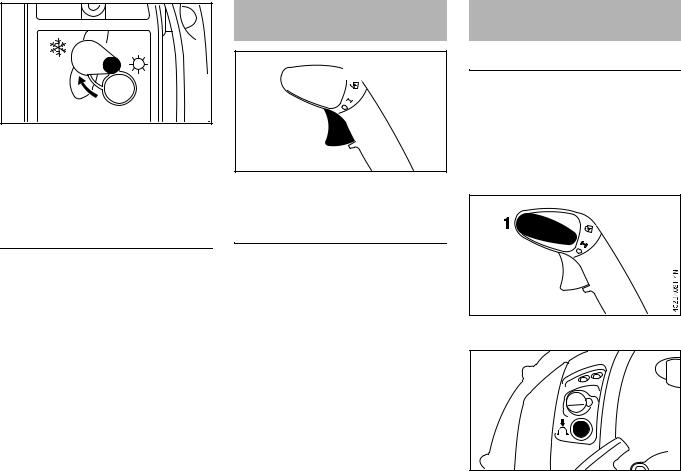

 4
4
 3
3
452BA086 KN
NSwing the shutter (4) to the winter position (r).
N Tighten down the screw (3) firmly.
NRefit the filter cover and air filter element.
At temperatures above 70°F (+20°C):
NAlways return the shutter (4) to the summer position (s)
NOTICE
since there is otherwise a risk of engine running problems due to overheating.
Information Before You Start
1 

2 |
KN |
|
452BA020 |
1 Setting lever
2Throttle trigger
The three positions of the setting lever
Engine stop 0 – ignition interrupted, engine stops. The setting lever does not remain in ths position, it springs back.
Normal run position F–enginerunsoris ready to start. Throttle trigger can be operated normally.
Lockposition C–thethrottletriggercan be locked in three positions: 1/3 throttle, 2/3 throttle and full throttle. To disengage the lock, move the setting lever (1) back to the normal run position F.
English
Starting / Stopping the
Engine
Starting the Engine
N Observe safety precautions.
NOTICE
Start your unit on a clean, dust-free surface only to ensure that no dust is sucked in.
N The setting lever (1) must be on F
452BA115 KN
NPress the manual fuel pump bulb at least five times – even if the bulb is filled with fuel.
BR 500, BR 550, BR 600 |
19 |
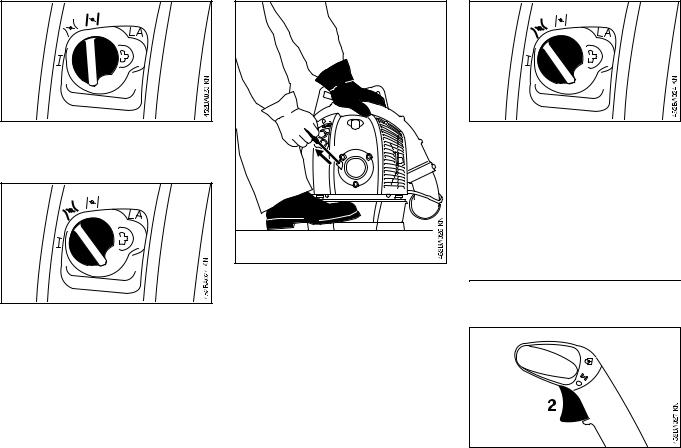
English
Cold engine (cold start)
N Turn the choke knob to l.
Warm engine (warm start)
N Turn the choke knob to n.
Also use this setting if the engine has been running but is still cold.
Cranking |
NPlace the unit securely on the ground and make sure that bystanders are well clear of the nozzle outlet.
NMake sure you have a firm footing: Hold the unit with your left hand on thehousingandputonefootagainst the base plate to prevent it slipping.
NPull the starter grip slowly with your right hand until you feel it engage and then give it a brisk strong pull. Donotpulloutthestarterropetofull length – it might otherwise break.
NDonotletthestartergripsnapback. Guideitslowlybackintothehousing so that the starter rope can rewind properly.
NCrank the engine until it begins to fire. After no more than three attempts, turn the choke knob to n.
When engine begins to fire
If the engine is cold:
NTurn the choke knob to nand continue cranking until the engine runs.
If the engine is warm:
Ncontinue cranking until the engine runs.
As soon as the engine runs
Return engine to idle speed:
NOperate the throttle trigger (2) – the choke knob automatically moves to the run position (F)
or
NTurn the choke knob to the normal run position (F).
20 |
BR 500, BR 550, BR 600 |
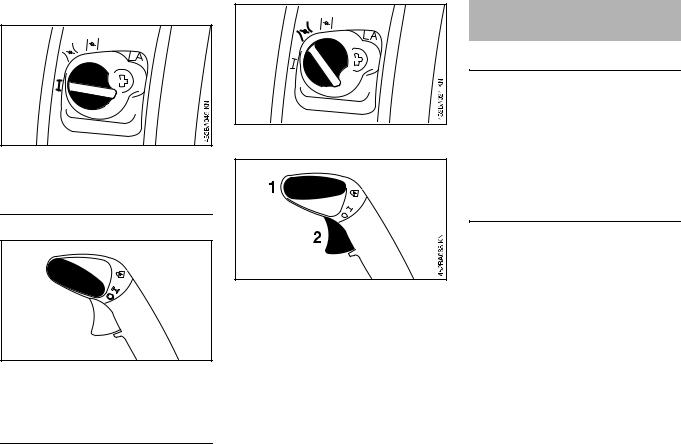
At very low outside temperatures
NOpen throttle slightly – warm up the engine for a short period.
Stopping the Engine
N Turn the choke knob to n.
1
452BA026 KN
NMove the setting lever to 0 – the engine stops – the setting lever springs back to the on position.
If the engine does not start
Choke knob
If you did not turn the choke knob to n quicklyenoughaftertheenginebeganto fire, the combustion chamber is flooded.
N Move the setting lever (1) to C.
NEngage the throttle trigger (2) in the full throttle position.
NContinue cranking until the engine runs.
Throttle cable adjustment
NCheckadjustmentofthrottlecable– see chapter on "Adjusting the Throttle Cable".
If fuel tank has been run completely dry and then refueled
NAfter refueling, press the manual fuel pump bulb at least five times – even if the bulb is filled with fuel.
NSet the choke knob according to engine temperature.
N Now start the engine.
English
Operating Instructions
During Operation
After a long period of full throttle operation, allow the engine to run for a short while at idle speed so that engine heat can be dissipated by the flow of cooling air. This helps protect enginemounted components (ignition, carburetor) from thermal overload.
After Finishing Work
Storing for a short period: Wait for the engine to cool down. Keep the machine inadryplace,wellawayfromsourcesof ignition, until you need it again. For longer out-of-service periods – see "Storing the Machine".
BR 500, BR 550, BR 600 |
21 |
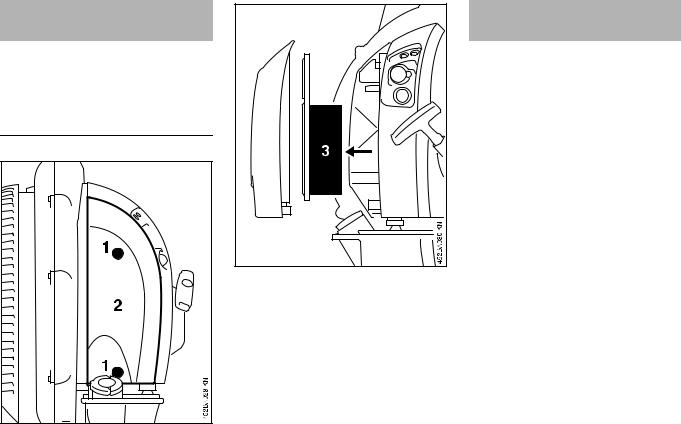
English
Replacing the Air Filter
Dirty air filters reduce engine power, increase fuel consumption and make starting more difficult.
If there is a noticeable loss of engine power
N Turn the choke knob to l. N Loosen the screws (1).
N Remove the filter cover (2).
Engine Management
Exhaust emissions are controlled by the design of the fundamental engine parameters and components (e.g. carburation, ignition, timing and valve or port timing) without the addition of any major hardware.
N Remove the filter element (3).
N Replace dirty or damaged filters.
N Fit the new filter in the filter housing.
N Fit the filter cover.
NInsert the screws and tighten them down firmly.
22 |
BR 500, BR 550, BR 600 |
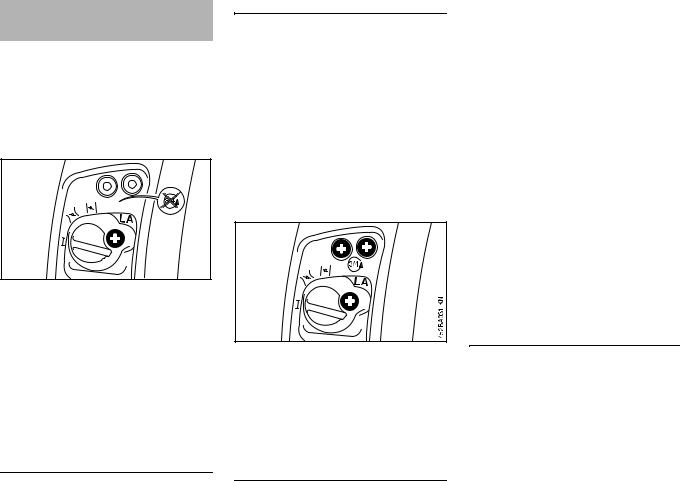
Adjusting the Carburetor
Machines without Adjustable Carburetor
On certain machine versions it is no longer necessary to adjust the carburetor. Such machines have no setting symbol on the shroud.
H |
L |
452BA105 KN
These machines have been set at the factory to provide an optimum fuel-air mixture in all locations and operating conditions.
Adjusting idle speed
Engine stops while idling:
NTurn the idle speed screw (LA) slowly clockwise until the engine runs smoothly.
Machines with Adjustable Carburetor
The carburetor comes from the factory with a standard setting.
Thissettingprovidesanoptimumfuel-air mixture under most operating conditions.
With this carburetor it is only possible to adjust the high speed and low speed screws within fine limits.
BR 500, BR 550, BR 600
Standard Setting
N Shut off the engine.
NCheck the air filter and clean or replace if necessary.
NCheck that the throttle cable is properly adjusted – readjust if necessary – see chapter on "Adjusting the Throttle Cable".
NCheck the spark arresting screen (not in all models, country-specific) in the muffler and clean or replace if necessary.
H |
L |
NCarefullyturnbothadjustingscrews counterclockwise as far as stop:
NThehighspeedscrew (H)is3/4turn open.
NThe low speed screw (L) is 3/4 turn open.
Adjusting Idle Speed
N Carry out the standard setting. N Start and warm up the engine.
Engine stops while idling
NTurn the idle speed screw (LA) slowly clockwise until the engine runs smoothly.
English
Erratic idling behavior, engine stops even though setting of LA screw has been corrected, poor acceleration
Idle setting is too lean
NTurn the low speed screw (L) counterclockwise, no further than stop, until the engine runs and accelerates smoothly.
Erratic idling behavior
Idle setting is too rich
NTurn the low speed screw (L) clockwise,nofurtherthanstop,until the engine runs and accelerates smoothly.
It is usually necessary to change the settingoftheidlespeedscrew (LA)after every correction to the low speed screw (L).
Fine Tuning for Operation at High Altitude
A slight correction of the setting may be necessary if engine does not run satisfactorily:
N Carry out the standard setting. N Warm up the engine.
NTurn high speed screw (H) slightly clockwise (leaner) – no further than stop.
NOTICE
After returning from high altitude, reset the carburetor to the standard setting.
If the setting is too lean there is a risk of engine damage due to insufficient lubrication and overheating.
23
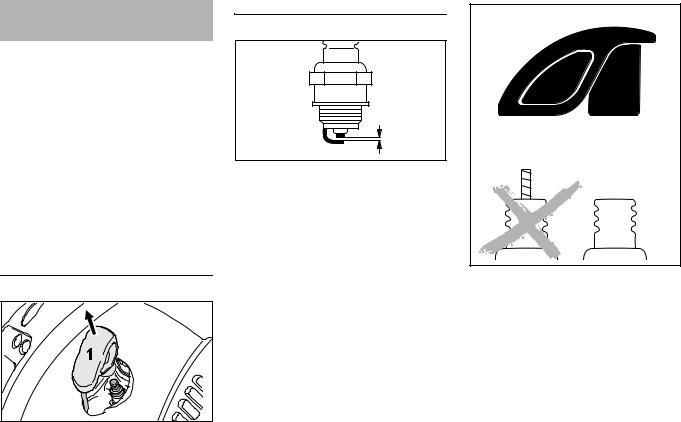
English
Spark Plug
If engine is down on power, difficult to start or runs poorly at idling speed, first check the spark plug.
Fit a new spark plug after approx. 100 operating hours or earlier if the electrodes are badly eroded.
Wrong fuel mix (too much engine oil in the gasoline), a dirty air filter and unfavorable running conditions (mostly at part throttle etc.) affect the condition of the spark plug. These factors cause deposits to form on the insulator nose which may result in trouble in operation.
Removing the Spark Plug
|
KN |
2 |
452BA092 |
|
N Pull off the spark plug boot (1). N Unscrew the spark plug (2).
Checking the Spark Plug
|
KN |
A |
000BA039 |
|
N Clean dirty spark plug.
NCheck electrode gap (A) and readjust if necessary – see chapter "Specifications."
NUseonlyresistortypesparkplugsof the approved range.
Rectify problems which have caused fouling of spark plug:
–too much oil in fuel mix,
–dirty air filter,
–unfavorablerunningconditions,e.g. operating at part load.
 2
2
002BA363 KN
 WARNING
WARNING
Toreducetheriskoffireandburninjury, use only spark plugs authorized by STIHL.Alwayspresssparkplugboot(1) snuglyontosparkplugterminal(2)ofthe proper size. (Note: If terminal has detachable SAE adapter nut, it must be securely attached.) A loose connection between spark plug boot and ignition wire connector in the boot may create arcing that could ignite combustible fumes and cause a fire.
24 |
BR 500, BR 550, BR 600 |
